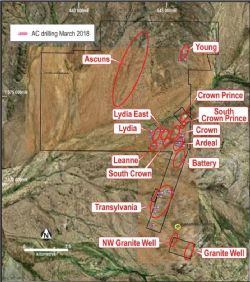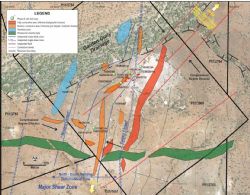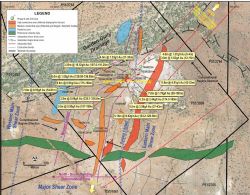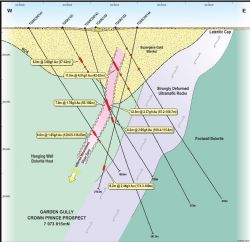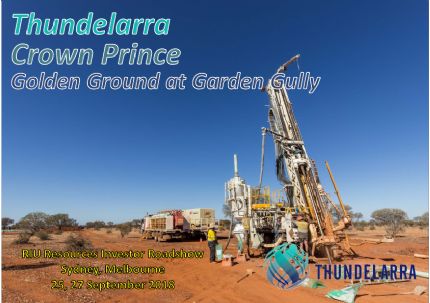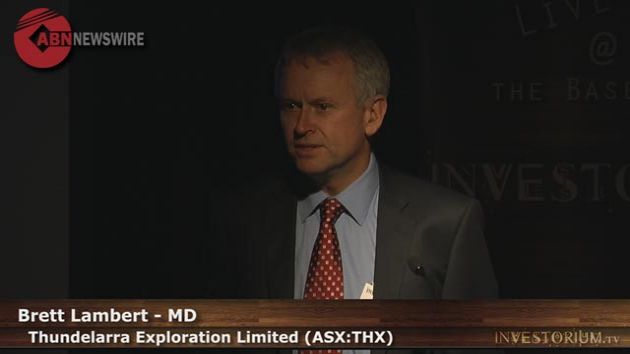 Crown Prince - New Gold Hits Plus Oxide Potential
Crown Prince - New Gold Hits Plus Oxide Potential
Perth, July 24, 2018 AEST (ABN Newswire) - Thundelarra ( ASX:THX) (
ASX:THX) ( TLXPF:OTCMKTS) is pleased to provide results of the diamond and reverse circulation drilling programme carried out at the Crown Prince Prospect, which forms just one part of our exciting Garden Gully gold project near Meekatharra, a well-established and proven gold production centre in Western Australia's Murchison Province.
TLXPF:OTCMKTS) is pleased to provide results of the diamond and reverse circulation drilling programme carried out at the Crown Prince Prospect, which forms just one part of our exciting Garden Gully gold project near Meekatharra, a well-established and proven gold production centre in Western Australia's Murchison Province.
- 17 holes drilled for 3,713m advance
- 11 reverse circulation ("RC") holes plus six RC pre-collars (2,560m)
- Six diamond ("DD") tails drilled for 1,153m advance
- New significant intersections at Crown Prince (downhole widths):
o 3.25m at 18.5 gpt Au from 107m in TGGRCDD142
o 6.0m at 4.0 gpt Au from 37m in TGGRC151
o 11.0m at 4.9 gpt Au from 42m in TGGRC153
o 5.0m at 3.6 gpt Au from 24m in TGGRC162
- Previously announced intersections (downhole widths):
o 3.5m at 7.6 gpt Au from 109m in TGGRC086
o 2.6m at 7.5 gpt Au from 130m in TGGDD090
o 4.0m at 16.5 gpt Au from 166m in TGGRC103
o 3.8m at 3.5 gpt Au from 220m in TGGRCDD108
o 2.40m at 66.5 gpt Au from 263.4m; within
o 5.65m at 29.2 gpt Au from 260.8m; within
o 8.00m at 22.3 gpt Au from 259.2m in TGGRCDD110
Full details in ASX announcements dated 15-Nov-2017; 12-Dec-2017; and 08-Feb-2108.
Gold mineralisation was intersected in 13 of 17 holes drilled in this programme: another excellent result that further confirms the potential present at Garden Gully and in particular at Crown Prince. The geological data from this programme, combined with the geophysical data from SAM surveys, have delivered improved understanding of the structural controls and solid indications that the known mineralisation at Crown Prince could repeat, and nearer to surface in the oxide zone, immediately to the northeast in previously untested areas.
Results from over 31,500m drilled in 167 holes (27,915m RC; 3,676m DD) since mid-2016 continue to indicate the presence of a major, previously undiscovered, gold-mineralised system at Garden Gully, in one of Western Australia's most productive gold provinces.
Conclusion.
This programme at Crown Prince continued to deliver outstanding results, further confirming the presence of high grade mineralisation in the known lodes and establishing the new geological theory that the mineralisation extends into the oxide zone to the northeast of the Crown Prince in areas never previously tested. This augurs well for future exploration at Crown Prince in particular.
In addition, the combination of data from this drilling and from the SAM surveys carried out suggests that the Western Contact could well extend to the western main shear zone (inferred position marked on the left-hand side of Figure 4)(see link below), which was never tested in the past. If the model is right, one or more repetitions of the same style as the Main and Northern Lodes could be present within the entire area bounded by the major north-south trending structures that bound the Deformational Zone shown on Figures 3 and 4(see link below). Mineralised structures of this style have been recognised to the south within the Crown, Ardeal and Battery prospects during the recent mapping programs and they clearly follow the margin of ultramafic or spinifex-textured basaltic units.
The areas of interest along those structures are the demagnetised sectors which show a higher grade of deformation. The Crown Prince Prospect, host to the best gold grades encountered to date within the entire Garden Gully project, is just such an area.
The priority drill target for the next exploration phase will be the northeast structural corridor where no drilling has been carried out to date. Multiple high-grade zones appear to be present within the weathering profile in this confined structural corridor. This area offers significant potential for previously undiscovered near-surface high grade oxide gold mineralisation.
Details of Drilling Programme Completed.
The programme was designed to test the area north of the main pit where the Main Lode crops out. It comprised 11 RC drill holes and a further six RC pre-collars with diamond tails for a total of 17 drill holes. Total advance 3,713m (RC 2,560m; DD 1,153m). Details of the holes drilled (collar locations and drill traces for each hole) can be found in Table 1 and Figure 3(see link below). Significant intersections are summarised in Table 2(see link below).
Three RC holes were drilled easterly just north of the main shaft, where the Main Lode crops out, with the aim of confirming the position of various mineralised intersections reported in historical drilling. Significant mineralisation was encountered (Figure 4, Table 2)(see link below) which included high grade gold intersections in TGGRC151 (6m at 4.0 gpt Au from 37m) and TGGRC153 (11m at 4.9 gpt Au from 42m) within the weathering profile.
Interpretation of the structural setting, based on the data obtained from the Sub-Audio Magnetics ("SAM") geophysical surveys conducted, indicates that the Northern Lode, rather than being a single mineralised structure as per historical interpretations, in fact appears to be just one of multiple Riedel structures carrying gold grades that are confined within a NNE trending structural corridor extending through and beyond the historical Crown Prince workings (see Figure 3 in link below). This is highly significant as it raises the possibility that the lodes mined historically at Crown Prince could repeat at shallower depths, in the oxide zone, to the north-east in an area not previously explored.
Holes TGGRCDD141-144 targeted the northern and down dip extensions of the Northern Lode. High grade gold was intersected in TGGRCDD142 (3.25m at 18.5g/t Au from 107m) which was drilled 40m north of the 7073815mN cross-section through the Northern Lode shown in Figure 5(see link below). Holes TGGRCDD143 and 144 were drilled south-easterly and south-westerly respectively from the 7073865N line, so their traces on Figure 5 (see link below) are not precisely in the same plane as that cross-section.
TGGRCDD143 intersected the Northern Lode, returning a significant zone of 13.5m at 2.2 gpt Au from 87.2m (including 2.3m at 3.6 gpt Au from 87.6m) and a second zone of 6.2m at 2.9 gpt Au from 109.4m down hole. TGGRCDD144 also intersected the Northern Lode: 6.2m at 2.5 gpt Au from 174.3m down hole.
Four holes drilled on the south-western part of the tenement were designed to test the down-dip extension of the Main Lode. Two were abandoned as the deviation on the RC pre-collars rendered them unsuitable for the planned deep diamond tails. TGGRC154 was drilled north/north-easterly and intersected an unpredicted mineralised shear zone between 117-125m. Another RC pre-collar was drilled behind this hole and finished with a deep diamond tail (TGGRCDD155). Low grade mineralisation was intersected between 119-130m (see Appendix 1 in link below).
TGGRC156 was abandoned at 167m due to high deviation. Another RC pre-collar drilled nearby was finished with a deep diamond tail to test at depth the western extension of the Main Lode (TGGRCDD157). This hole intersected the same northerly trending mineralised high-strain shear zone between 178-193m and an alteration zone between 414-422m without returning any significant gold anomalism. SAM surveys were subsequently undertaken, interpretation of which shows that this mineralised structure is the high-strain zone which bounds the Main Lode to the west (see Figure 3 in link below). The Main Lode was intersected as expected below 325m down hole and appears to split into several branches carrying narrow low-grade gold values. All the significant assay results between 325.8-352.4m interval are shown in Appendix 1(see link below).
TGGRCDD161 was drilled within the median section of the WNW-ESE trending extension of the Main Lode inferred from the SAM interpretation. The hole intersected the lode between 175-180m and returned low-grade gold mineralisation (5m at 0.9gpt Au).
The programme also tested the shallow supergene gold present north of the Main Lode where the Northern Lode was targeted by miners at shallow depths. Four holes were drilled within this area (TGGRC162, 164-166: Figures 3, 4)(see link below). TGGRC162 intersected the Northern Lode at shallow depth, returning 5m at 3.6gpt Au from 24m, with TGGRC164 returning 4m at 1.3 gpt Au from 31m.
TGGRC163 tested the Western Contact between ultramafic rocks and dolerite/high-magnesium basalts. Highly anomalous gold were returned from this high strain zone (see Appendix 1 in link below) which remains prospective both to the south and to the north-east.
Structural interpretation from the SAM and regional aero-magnetic data shows that both the Main and Northern Lodes are located within a deformational zone where its trend turns from NNE to more clearly northeast-southwest and narrows due to the change in the compressional regime from east-west to northwest-southeast (see Figure 3 in link below). Such a change in the compressional regime creates the low pressure shadows/dilational zones that offer the best locations for gold mineralisation, especially when combined with the contrast between more competent dolerite/high-magnesium basaltic rocks and the underlying more ductile ultramafic unit, with the latter also acting as the reductant needed to drop the gold out of the mineralising fluids.
This can also explain the fragmentation of the Main Lode in the zones between the several sub-parallel high-strain shears present in the deformational zone between the Western and Eastern contacts where the gold mineralisation has been intercepted to date.
About Garden Gully.
Thundelarra's wholly-owned Garden Gully project comprises 15 granted Prospecting Licences and 2 granted Exploration Licences covering about 78 square kilometres, located in Western Australia's Murchison region about 20 kilometres north-west of the town of Meekatharra, a well-established and proven gold endowment centre in Western Australia's Murchison Province that has delivered in excess of seven million ounces of gold production to date.
Historical gold production from Garden Gully totalled about 21,000 ounces at approximately 21 grams per tonne. This was mined during the period 1909 to 1915 and was primarily sourced from Crown Prince (formerly known as Kyarra) and from a maximum reported depth of 120m.
Thundelarra began exploration at Garden Gully in mid-2016 and continues to explore the project aggressively as we test the unquestioned potential of the exciting Garden Gully project.
To view tables and figures, please visit:
http://abnnewswire.net/lnk/154J86U5
About Ora Gold Ltd
 Ora Gold Ltd (ASX:OAU) is an ASX-listed company exploring and conducting pre-production activities on its Abbotts and Garden Gully tenements near Meekatharra, Western Australia. The near-term focus is of low cost development of its already identified shallow mineralisation, while investigating the potential extensions for larger deposits.
Ora Gold Ltd (ASX:OAU) is an ASX-listed company exploring and conducting pre-production activities on its Abbotts and Garden Gully tenements near Meekatharra, Western Australia. The near-term focus is of low cost development of its already identified shallow mineralisation, while investigating the potential extensions for larger deposits.
![abnnewswire.com]()
Related Companies
Social Media
Share this Article

 ASX:THX) (
ASX:THX) ( TLXPF:OTCMKTS) is pleased to provide results of the diamond and reverse circulation drilling programme carried out at the Crown Prince Prospect, which forms just one part of our exciting Garden Gully gold project near Meekatharra, a well-established and proven gold production centre in Western Australia's Murchison Province.
TLXPF:OTCMKTS) is pleased to provide results of the diamond and reverse circulation drilling programme carried out at the Crown Prince Prospect, which forms just one part of our exciting Garden Gully gold project near Meekatharra, a well-established and proven gold production centre in Western Australia's Murchison Province.  Ora Gold Ltd (ASX:OAU) is an ASX-listed company exploring and conducting pre-production activities on its Abbotts and Garden Gully tenements near Meekatharra, Western Australia. The near-term focus is of low cost development of its already identified shallow mineralisation, while investigating the potential extensions for larger deposits.
Ora Gold Ltd (ASX:OAU) is an ASX-listed company exploring and conducting pre-production activities on its Abbotts and Garden Gully tenements near Meekatharra, Western Australia. The near-term focus is of low cost development of its already identified shallow mineralisation, while investigating the potential extensions for larger deposits.


